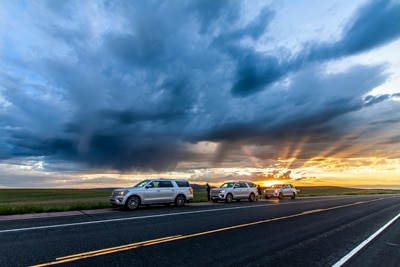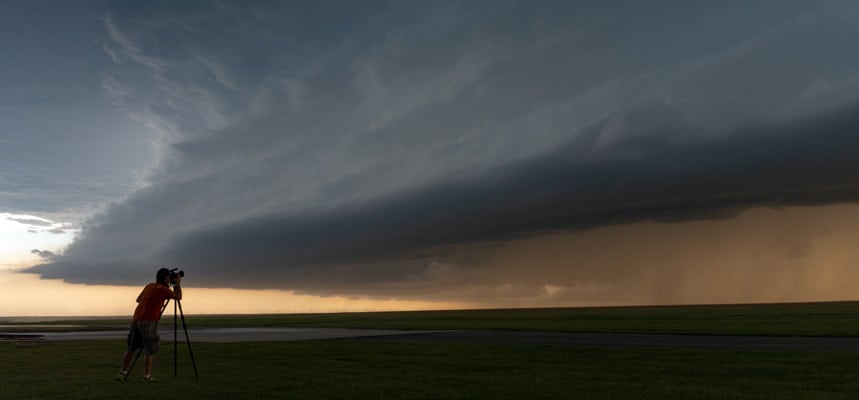
Storm chasing has become much more popular over the years thanks to reality television. These shows chronicle the action, showing chasers attempting to get ever closer to severe storms and tornadoes.
The spotlight on storm chasing has attracted more and more to the hobby, and some have even made quite a bit of money doing it. You can, too, but it’s not as easy as you might think. In this blog, we’ll provide you with some information to get started, and potentially get paid doing it.
What Is a Storm Chaser and What Do They Do?
The definition of a storm chaser has expanded. Years ago, a “storm chaser” was someone who chased tornadoes. These days, storm chasers track, observe and record all kinds of severe weather from hurricanes to floods, and even winter storms. In many cases, they’ll take instruments with them for research, or cameras to document the events.
Some chase for the thrill of it, and others do it for scientific research. Then others chase for the potential to catch some thrilling video, which can potentially sell for hundreds if not thousands of dollars. There are many reasons, and some chasers have multiple reasons for doing what they do.
For me, storm chasing is just an extension of my fascination with the weather. There’s nothing more thrilling than getting up close and personal with the worst that mother nature can throw at you.
Is Storm Chasing Important?
While there has been a good deal of controversy regarding storm chasing thanks to some irresponsible chasers (and unfortunate accidents), storm chasing plays an important role. Much of what we understand about severe weather and tornadoes today is thanks to the work of the earliest chasers.
Most storm chasers report what they see to their local weather service offices, which helps in issuing more accurate warnings and forecasts. The footage some chasers film makes it onto the news, which highlights the dangers of severe weather, and informs the public.
Famous Storm Chasers
While there are perhaps thousands of chasers across the nation, only a small handful are what most would consider famous. Probably the most famous is Reed Timmer. He’s made a name for himself on the Discovery Channel series Storm Chasers by driving into tornadoes and other severe weather with a heavily armored vehicle known as The Dominator.
There are others, but most are only famous within the storm chasing community itself.
How to Become a Storm Chaser
How do you start storm chasing? Before you go out, you want to be sure to understand the basics of how our atmosphere works. My recommendation is to familiarize yourself with severe weather first, and how to stay safe. The TORCON Index can be a great help, too.
Remember that storms are very dangerous and can sometimes be deadly. Professional storm chasers have meteorological training, which allows them to understand the weather systems they’re chasing. They also learn by working with other experienced storm chasers. You should never try and pursue storms without training and an experienced mentor working with you to show you the ropes.
Become a Skywarn Storm Spotter
Storm chasing requires a bit of training. The first thing you’ll want to do is attend storm spotter training and volunteer as a Skywarn storm spotter (in Canada, it’s Canwarn). This program is especially important if you didn’t have a keen interest in the weather before. While these classes won’t teach you how to storm chase, they’ll show you the basics of how to spot severe weather, what to report, and some essential safety tips. Volunteering with Skywarn is not only a great way to learn about severe weather and gain valuable experience, but it will also help your community.
If possible, and your local National Weather Service office offers it, you’ll want to take both the beginner and advanced classes. Expect to spend about two hours for each class and bring something with you to take notes.
Beyond this, spend time researching how thunderstorms and tornadoes form and move. This research helps you learn where you need to be for the best shots and keep you out of harm’s way, as storm chasing can be very dangerous.
Find a Mentor
Once you have built up your hour’s storm spotting with Skywarn, look for an experienced storm chaser who can potentially become your mentor to further your learning and eventually take you on your first expedition to chase severe weather. The Skywarn program is a great way to find a mentor, and the Stormtrack online community is another avenue to connect with experienced chasers.
Do Storm Chasers Get Paid?
The short answer is yes. The longer answer is a bit more complicated. Read on to find out why.
How Much Do Storm Chasers Make?

It’s time for a reality check when it comes to the moneymaking side of storm chasing. The vast majority of storm chasers make little money if any at all. There are a few reasons. First, the difficulty of being in the right spot at the right time cannot be understated. While you’ll get good at this with time, some of it does come down to luck.
Second, and this is thanks to social media, media outlets don’t have to rely on paying storm chasers for footage anymore. People often don’t realize they don’t need to give away their footage for free online, and that they could sell it, especially if it’s high quality. Much of what we see on our newscasts is content they have gotten for free if one of their photographers captured it.
Finally, it’s challenging to sell footage on your own. In my case, I work through what’s called a broker—essentially a middleman or salesman for my footage. They have agreements with various news outlets and take a portion of my sale as a commission. It’s very, very difficult to sell it on your own unless you have connections. Trust me. I’ve tried.
What brokers sell storm chasers videos? There are a few significant companies, including Live Storms Media, Severe Studios, and SVL Media, to name a few. These are hard to get into unless you have some sellable video already. Most require you to submit some samples to help you sell your footage.
Videos often sell between $100-300 (and occasionally more) depending on length, content, and newsworthiness.
Storm chaser jobs are few and far between. Most are in the Midwest, and news outlets typically will align themselves with well-known chasers, as they have the best chance of getting good quality video.
The reality is a majority of those that get paid for storm chasing make in the order of a few hundred or a few thousand a year, but nowhere enough to make it a career. Outside of the Midwest and ‘Tornado Alley,’ there’s not enough severe weather to have the potential to sell.
Basic Storm Chasing Equipment
Of course, the most critical piece of gear is your vehicle. If possible, don’t use your primary vehicle. Use one that you’re less concerned with damaging. During storm chasing, you may find yourself getting pelted with debris, hail, or may find yourself in high water. You’ll also want a car that is in good working order. Storm chasing is rough on your vehicle, and you’ll put a lot of miles on the odometer to find that perfect shot.
Here’s some essential storm chasing gear that I recommend you consider:
- A good radar app. The Weather Channel or AccuWeather app won’t cut it. Choose an app with real-time weather data. My favorite is RadarScope. These apps also give you access to other radar products that may help you in positioning yourself for a great shot.
- A weather radio. Listening to a weather radio may help you in your chase, primarily when warnings are issued. An emergency weather radio can help you be sure you’re on a storm that has the highest potential to produce severe weather. Your judgment will help you much more, though, as warnings often provide insufficient time to catch up to a severe storm if you’re not nearby. Take a look at our guide to see the best weather radios.
- A hotspot. You will be on your phone quite a bit, looking at radar data. Get a cellular hotspot so that you can connect your phone to that instead. Some plans throttle users for using too much data or don’t include unlimited data. A hotspot will also come in handy if you have a laptop. When selling footage, timeliness is critical. You’ll want to send these videos off as soon as possible, often in the field, to better your chances of a sale.
- A good camera and a tripod. If you have access to a DSLR or higher-end video camera, this is best. Steady footage sells too, so you’ll want to purchase a tripod. Can you sell smartphone video footage? Yes, but it needs to be in landscape mode, very steady and recorded using a high-quality video setting. I’ve sold footage from my iPhone, but even with the iPhone, I use a tripod to get high-quality shots.
- Food. This seems funny to add here, but you’ll likely be on the road for long periods. You’ll only want to stop for quick breaks, especially on busy days, where time is of the essence. Bring a cooler along in the car with snacks and drinks.
- A copilot. Don’t chase severe weather by yourself. Having a second pair of eyes is vital on challenging journeys. You’ll not only have to worry about the weather itself, but also pay close attention to the road. Most storm chaser accidents (and worse yet, deaths) occur as a result of distracted driving.
What Storm Chasing Video Sells?

What kind of video sells? The easiest way to think about this is to consider what you see on your local news. Steady video is vital as I said before, but also keep in mind to stay quiet while you film. Don’t narrate what’s going on, and most importantly, don’t swear. Make sure the subject is in focus.
Watch the video you see on the news. Notice how shots are framed. You’ll want to mirror these techniques.
While panning is okay, a steady shot is better. Only use panning if it’s necessary to convey the scope of the event, especially when it comes to damage. When possible, stay on a shot for a count of ten. This technique makes the job of the video editor much more manageable and will increase the chance of a sale.
Here’s a list of potential situations which may yield sellable video:
- Video of weather in progress. For example, a tornado, hail, flooding, wind damage, heavy snow.
- Footage of damage after a weather event.
- Footage of people dealing with the weather in question. For example, cars driving through flooded roads, stranded vehicles, walking down sidewalks).
- In-person interviews. Have a good quality microphone ready. Ask the person to say and spell their name, or at least give some identification (a first name or appropriate nickname is fine; some people don’t feel comfortable providing that information). Without a microphone and identifying information, the video won’t sell.
- The day-after footage. Major weather events can be multi-day events. Some chasers make additional money selling a video of the cleanup afterward, even if they’ve already sold footage of the weather event itself.
- The day before footage. News outlets will need a video of preparations too. There may be an opportunity for a hurricane chaser to get a video of people boarding up homes and businesses. This footage often sells just as quick as videos of the event itself if it’s a big enough story.
PLEASE BE RESPECTFUL WHEN SHOOTING VIDEO!
Remember, with severe weather damage, that’s somebody’s life. Don’t automatically assume they want to be filmed. If you need to enter somebody’s property to shoot video, ask first. Identify yourself as a news photographer and ask for permission. If they say no, don’t argue and thank them for their time and wish them well.
In public places, you may film wherever you like, as long as you’re not in a restricted area. However, even in these situations, keep other people’s privacy in mind. Don’t zoom in where people are easily identifiable—wider shots are fine.
A Few Parting Words
I know that you might have read through this article, and the reality of how difficult and how dangerous storm chasing is, might not be what you wanted to hear. It’s not easy, however, with the right training, guidance and with time, you’ll get better not only with chasing but at shooting video that can sell.
Have any questions? We’d love to answer them in the comments below. Good luck, and stay safe!




